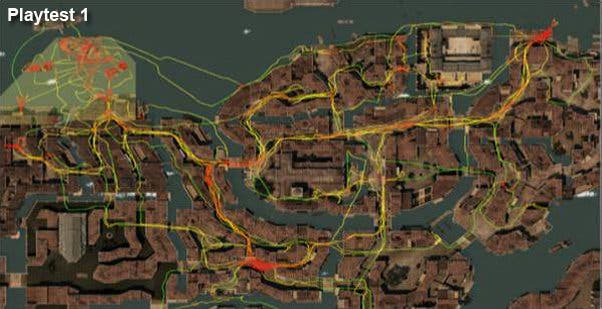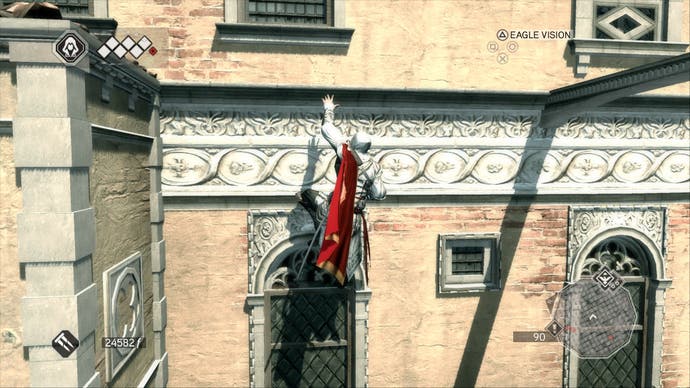Designing Assassin's Creed II
230 new features, 200 design documents, 300 staff, no time for revisions. How did Ubisoft Montreal deliver?
It turned out that the casual players weren't getting to grips with the navigation system, while the gamers that were perceived to be more "hardcore" by the team were maximising the potential, appreciating it a lot more and getting more fun from the mission.
"The decision was made not to change the layout. Why? Because hardcore players didn't appear to have any problems so technically it was functioning well," Plourde reveals.
"Secondly, our first city that the players would see in the game - Florence - had lower buildings. So once the player reached Venice, the last city in our game, they would be acclimated to free-running. That was the educated guess that we made... that casual players who reached Venice would become what we would call a hardcore player. They would think that the navigation was fluid enough."


And that fluidity was key, leading to one of the most crucial improvement to the parkour system. Taller buildings meant that they took longer to climb, and the feedback from the playtest was that it just didn't feel right. In the original Assassin's Creed, players would climb, then return to a neutral pose before being "allowed" to climb again. In ACII, this was refined with the neutral pose removed, to facilitate what the team called the "strong climb".
"The character would then reach the rooftops twice as quickly as he did in AC1," says Plourde.
"So if you have a four-storey building, you have the same speed as you would in reaching a rooftop in AC1. We also made a change to the environments in that every free-running path would lead to the rooftops. So players would start do the free-running and the designer would guide him to the rooftops and to happiness!"


A more difficult challenge that arose in the playtest was the concept of using the crowd to blend. To put it simply, despite the design feeling "right", the gamers just didn't get it, and thus didn't use it.
"The system worked, I'd play it at work and it worked for us, we understood the matrix, yet people didn't understand it," Plourde says with frustration.
"It was really simple - you hold the B button when you're next to a group and then blend - you walk automatically within the group. People didn't understand it at all... We had to find a solution. When people say that playtesters are going to come into your building and say nice things about your game because you're the developer, it's not the case! Blending was rated badly by players."
The idea came to make the blending system completely automatic, activating on its own depending on your proximity to the crowd. However, the coders weren't happy about the prospect of rewriting an important system within the game. The solution turned out to be astonishingly simple.
"I'm at my desk thinking, why don't the players just hold the B button? It's that simple!" Plourde remembers.
"So I taped the B button down. It's automatic, and it works... it took maybe two hours to code in that cheat so that when you're walking you're just automatically holding the B button. The thing is, as soon as we implemented that, the player impressions on blending changed from something that was bad to something that was good, so we're really happy about that. Not only that, but every mission that required the player to be stealthed had the difficulty lowered and the fun factor raised."
Plourde's final example of how valuable playtest is didn't have a happy ending. User feedback on the fight system - one of the core gameplay pillars - showed that the player thought that the whole process lacked variety.
"We know - because we tracked what he did - that he didn't use all the moves," Plourde says, explaining the result.
"So what we did was compare his results with one of our designers who knows the system. You really see a difference in the usage and that's how we perceive the fight system. The problem is that we didn't find a solution and it shows in reviews and appreciation. If there's one thing people are talking about, it's how the fight isn't as focused as it could be and that's where we failed. I just wanted to give that example to say that when you're going through playtest, sometimes you can analyse it but you're not necessarily going to have a solution for it. But at least in case we have a sequel (located in Rome!) then you're going to be able to solve it."
So, 300 developers, 230 features and zero scope for revision. Now you know how the team did it, and presumably those same systems are in place for that Rome-based sequel, due at the end of this year.
Concluding his GDC presentation, Patrick Ploude talks in broad brushstrokes about the lessons learned after his years in making the Assassin's Creed games.
"In making big-budget games, mistakes can prove extremely costly. If you start derailing a 300-man production it can go wrong really fast," he shares.
"Also it leads to lower quality if people work on stuff that isn't going to ship. It creates needless work, lower morale. Go to a programmer who worked really hard on a feature for two months, cut it, and then tell him this is a new feature you need him to work on. See how he's going to react. That could lead to a lot of fail."
"Designers can lower that risk by looking at what's in the core of the game, and building around it, providing the art team with strong documentation that fits their production needs, and maximising the playtest to validate decisions and to make informed calls. And with that, in the end, we produce the anti-fail!"
















